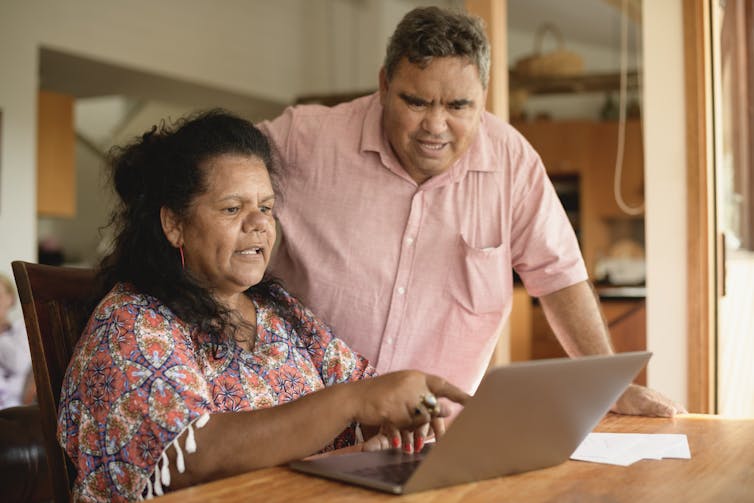misinformed and malicious comments stifle Indigenous voices
- Written by Tristan Kennedy, Associate professor, Macquarie University

Content warning: This article contains mentions of racial discrimination against First Nations people.
Comments pages on social media too often constitute an echo-chamber for racist rhetoric being peddled by a combination of the misinformed and the malicious.
It seems Australians have, in recent times, recognised racism as a serious problem in this country[1]. Nowhere is the discussion about racism in this country more visible than on social media.
Mainstream media outlets have embraced social media as an avenue to publish regular articles about Indigenous peoples and racism. These posts regularly elicit comments that are misinformed, malicious, and aimed at delegitimising Indigenous peoples’ culture and identity.
Such misinformation needs to be eradicated if the conversations about Australia coming to terms with its past is going to move forward.
Read more: Technology-facilitated abuse of Aboriginal and Torres Strait Islander women is rife in regional and remote areas[2]
‘Don’t read the comments’
Indigenous peoples are quite vocal about avoiding the quagmire of negativity in online comments pages. Racist tropes get dug up, recycled, and levelled at Indigenous peoples. This is often done in order to silence Indigenous voices and call into question Indigenous identity.
This is not new. In 2018 Professor Bronwyn Carlson and Dr Ryan Frazer found[3]
Some respondents reported being questioned over whether they were “really Indigenous”, with critics drawing on stereotypical ideas — particularly about skin colour.
Challenging Indigenous identity based on skin colour is a well-known racist strategy.
In other cases, online comments resemble what is called “sealioning” which, according to[4] journalist Chris Stokel Walker,
is the process of killing with dogged kindness and manufactured ignorance by asking questions, then turning on the victim in an instant.
One example of this is found in research into Indigenous peoples and social media[5]. In this research, one participant recalled a post they had seen recently:
[…] there was one commenter just said “I’m confused”, obviously pointing out that how is this person Aboriginal when they’ve got such white skin.
Feigning confusion is a common strategy deployed to call into question Indigenous identity. The alleged confusion is often based on colonial ideas that Indigenous culture is ancient, uncivilised, and incompatible with modern Australia. The aim: to silence Indigenous voices by delegitimising Indigenous peoples’ connection to community, culture, and identity.
Mainstream media on social media
On April 7 this year, NITV published on Facebook the story of AFL player Eddie Betts’ reflection [7] on his decision not to speak up about the racism he faced early in his AFL career for fear of the retribution.
One of my research participants noted, articles about racism in Australia “only serve to just basically invite hundreds more comments of horrible racist rhetoric”. The publication of Betts’ story was no exception.
One commenter echoed the worn-out trope of Indigenous identity being legitimate only when it is considered “traditional”.
They never do the “traditional” thing where their [sic] was no concept of personal property within the clan […] otherwise they wouldn’t have their mansions, flash cars.
The sentiment here is that the only acceptable Indigenous identity is one which rejects technology, money, or anything considered “modern”.
Read more: Media inclusion of Indigenous peoples is increasing but there is still room for improvement[8]
What can moderators do?
Social media platforms are interested in stamping out negative content on their platforms. In February 2021 many of the industry’s largest players signed up to a Code of Practice on Disinformation and Misinformation[9].
Also in 2021, Facebook announced a new admin tool for moderators to “nurture community culture[10]”. This admin tool, powered by artificial intelligence, would alert admins to situations in the comments pages threatening to escalate to a breach of community standards.
Combating the specific types of racist rhetoric faced by Indigenous peoples however, presents unique challenges. Sealioning and feigned confusion sidesteps artificial intelligence as well as non-indigenous peoples’ familiarity with harmful content. The comments typically don’t always include key racist terms and slurs, rather they can appear as confusion and lines of often excessive questioning.
The damage done by the persistence of subtle racism, sealioning and challenges to Indigenous identity in comments sections remains difficult to measure.
What can be done?
Indigenous peoples identify social media as a site for collaboration and connection. Deliberately racist lines of questioning are identified by Indigenous peoples and allies and quickly challenged. In some cases, the responses to racist comments demonstrate some Indigenous peoples’ willingness to educate.
Yet, systems need to be in place to better monitor these interactions, because these interactions often deteriorate into even more violent and racist altercations. However, allies calling out racist trolls could contribute to setting a standard of conversational etiquette and better facilitate meaningful discussions.
One research participant told me:
I think that people’s comments have a lot to do with just not being educated on the real truth of what has happened to all of our peoples.
As more people call out misinformed and malicious commentary, more will begin to understand the complexity of identifying as Indigenous online.
This will help inspire honest conversation about Australia’s past and what it means to be Indigenous.
References
- ^ recognised racism as a serious problem in this country (www.theguardian.com)
- ^ Technology-facilitated abuse of Aboriginal and Torres Strait Islander women is rife in regional and remote areas (theconversation.com)
- ^ found (theconversation.com)
- ^ according to (www.theguardian.com)
- ^ social media (research-management.mq.edu.au)
- ^ GettyImages (www.gettyimages.com.au)
- ^ reflection (www.sbs.com.au)
- ^ Media inclusion of Indigenous peoples is increasing but there is still room for improvement (theconversation.com)
- ^ Code of Practice on Disinformation and Misinformation (digi.org.au)
- ^ nurture community culture (www.facebook.com)













